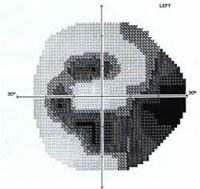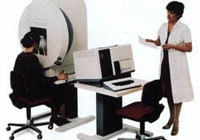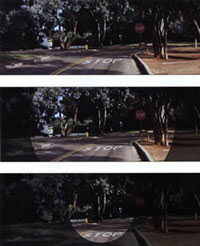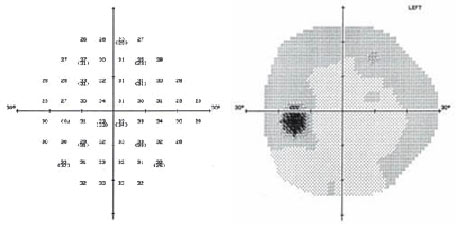Visual Field Test

In glaucoma testing a visual field test is performed to measure peripheral (side) vision or visual field to determine if there is damage from glaucoma. One may have glaucoma and not be aware of it. In most individuals, there is no sudden change, which signals either the onset or progression of glaucoma. As the nerve fibers in the optic nerve (the cable that transmits the visual message from the eye to the brain) are damaged in glaucoma, there is a gradual and painless loss of vision. Initially, glaucoma affects peripheral (side) vision (Figure 1). The loss often goes unnoticed. However, if untreated, glaucoma may eventually affect central vision, as well. Usually it is only with this more advanced stage of glaucoma that one can recognize loss of vision without special tests.
An example of a visual field examination, in an eye with glaucoma. This test is performed to measure peripheral (side) vision or visual field. With this test, the visual field looks like a map. Light areas are those which are seen best. Dark areas are seen poorly.
“Initially, glaucoma affects peripheral (side) vision… if untreated, glaucoma may eventually affect central vision.”
What Is A Visual Field?
The term visual field refers to the area of a scene you can see with your eyes fixed on one location. For example, while watching a stop light, you may notice a car pulling up beside you in the next lane. Your peripheral vision enables you to see the movement of the car. The visual field is quite extensive when both eyes are working properly (Figure 2), but with glaucoma, the field of view is reduced.
How Is The Visual Field Measured?

Most ophthalmologists measure the visual field using an instrument called a perimeter. To take the visual field test, you are seated with your head in a chin rest to maintain a stable position. The person giving the test will then request that you look straight ahead at a small steady light and not move your eyes.
While looking at this steady light, small white lights are flashed on and off around it (above, below, or to the side). These flashes occur one at a time. The location of the test lights corresponds to locations on the retina. The retina is the light-sensitive film, which lines the inside of the eye. All fibers in the optic nerve, including the ones, which are damaged in glaucoma, originate from the retina.
With both eyes working properly, the visual field is extensive (top), but as glaucoma worsens, the field of view can be reduced (middle) until it appears as if you are looking through a tunnel (bottom).

When a light flash is seen, you press a button, which in turn, signals a computer. A computer keeps track of your responses and adjusts the flashes by making them brighter or dimmer at each location tested in the visual field.
The purpose of the visual field test is to determine how bright a flashing light must be at each particular location in order to be seen. In every test, there will always be some flashes, which are too dim for even normal eyes to see. Results obtained from the test are compared to what is known about visual field tests in normal eyes. In general, the ability to detect these flashing lights is reduced at characteristic locations in glaucoma. In other words, the lights need to be brighter before they can be seen.
“In every test, there will always be some flashes which are too dim for even normal eyes to see.”
Advice For Taking A Visual Field Test
There are several things you can do to be sure you are giving the most accurate responses to the test:
- You should be well rested. If you are tired or ill, you should ask your ophthalmologist if the test should be postponed.
- You should make sure you are seated at the perimeter as comfortably as possible. The tests often take 15 minutes to complete in each eye; so comfort is important. Let the person giving the test know if you feel hunched over or if the chin rest is too high.
- You should always look at the target light. The location of the test lights during the test corresponds to locations on your retina. If you do not look around, your ophthalmologist can more accurately determine from the visual field where damage has occurred.
- You should let the technician know if you need to take a break in order to scratch your nose, cough, or take a rest.
- Do not be concerned if you do not see all the lights. With every test, there will be lights that even someone with normal vision will not be able to see.
What Does The Visual Field Test Tell Your Ophthalmologist?
When your ophthalmologist looks at the map of your visual field, they are looking for areas that are less sensitive to light than what is found in a healthy eye (Figure 4). Certain areas of the visual field are more often affected in glaucoma (Figure 5). These can help your ophthalmologist to diagnose glaucoma and start early treatment.

If you have glaucoma, and some loss of visual field is present, you will be followed carefully with repeated testing to determine if the problem has been halted or if further loss is occurring. With further loss of visual field, you often will require additional treatment. The time interval between visual field tests depends on many different factors, and is best determined by your ophthalmologist.
This ongoing and repeated testing is very important for the proper management of your glaucoma.
In a healthy eye, the central portion of the visual field corresponds to the area of best vision. On the left, the numbers tell how bright the test lights had to be in order to be detected. Higher numbers indicate better vision. On the right, the visual field map shows the lightest areas (best vision) are in the center, with some reduction in sensitivity in the periphery, even in the normal field. The darkest area corresponds to the normal blind spot.
The glaucoma eye shown here required more light than normal in all areas of the field. The numbers on the top are lower, indicating poorer vision. The visual field map (bottom) is much darker than normal, especially in the peripheral areas.


 DONATE NOW
DONATE NOW